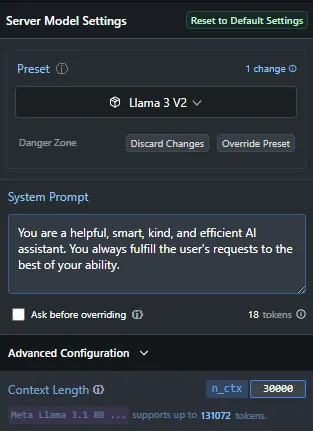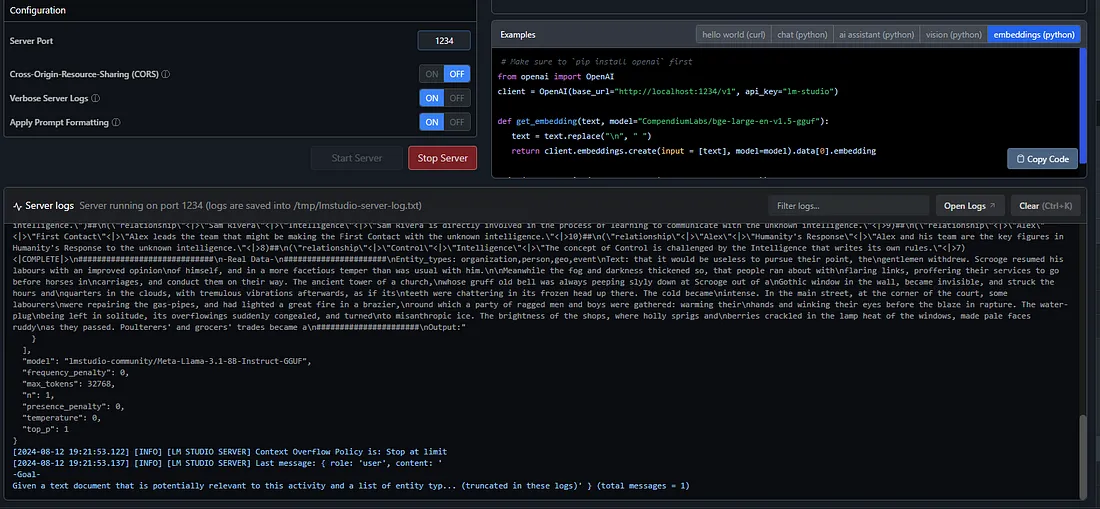Microsoft GraphRAG:RDF知识图谱的应用与解析(第1部分)
和很多人一样,我读过微软关于 GraphRAG 的论文,想尝试一下。但是,它需要大量调用 OpenAI 兼容模型,这很快就会证明成本非常高。听说可以在本地运行这些模型而无需花费成本,所以我想自己尝试一下。
本地服务器要求
在选择本地运行的服务器时,我提出了一些符合 Microsoft GraphRAG 工作方式的要求:
- 能够使用 GGUF 格式的模型
- 聊天和嵌入的端点
- 开源
- 能够在本地计算机上运行
- 不向外部网站传递数据
GGUF 格式
为什么我要求使用 GGUF 格式的模型?LLM 模型名副其实--非常庞大!当你将训练好的模型连同权重一起保存时,生成的文件将达到数千兆字节。为了减小文件大小,可以将其转换为 GGUF 格式。这不仅能减小文件大小,还能加快模型加载速度。
llama.cpp
大多数可在本地运行的服务器似乎都是基于名为 llama.cpp 的开源产品构建的。如果访问他们的网站,就会看到使用其产品的用户界面列表。这个列表非常有用,因为你知道它们都能使用 GGUF 格式的模型。
我开始使用的是 Ollama,因为它目前相当流行。但使用最新版本时,你必须将 GGUF 导入他们的系统,然后转换成他们自己的专有格式。如果下载文件,情况也是一样。我不喜欢看不到 GGUF 文件,所以我从列表中选择了另一个用户界面: LM Studio
LM 工作室
我从 LM Studio 网站下载了最新版本的 LM Studio,然后下载了一个用于聊天的模型(我使用的是 Meta-Llama-3.1-8B-Instruct-Q4_K_M.gguf)和一个用于 Embdedding 的模型(我使用的是 bge-large-en-v1.5-f32.gguf)。
配置
为了使模型能在 Microsoft GraphRAG 中很好地工作,有一些地方需要更改。下载我们要使用的模型后,选择加载它们:

在右侧,你将看到服务器的设置。加载模型时,它会设置这些值,同时也会选择一些默认设置。我们需要更改的默认设置之一就是上下文长度。随着模型不断改进并变得越来越大,它们也允许更大的上下文长度。当你加载模型时,它会知道最大的上下文长度。但默认值只有 400,这就相当小了。我将上下文长度设为 30,000,以应对我们可能要处理的大块文本(GraphRAG 的默认值为 12,000):

下一步是加载嵌入模型:

现在,我们可以设置 Microsoft GraphRAG 并使用本地服务器运行它了。
运行 Microsoft GraphRAG
如果你按照 “入门 ”页面的帮助创建了初始环境,那么你需要调整 “ragtest ”文件夹中生成的 2 个文件。
.env 文件
该文件通常存储 OpenAI 账户的 API 密钥。对于我们的设置,只需将密钥值更改为 “lm-studio ”即可:
GRAPHRAG_API_KEY=lm-studio
settings.yaml
该文件中需要更改的重要内容有:
- 我们正在使用 OpenAI 聊天 API(第 6 行和第 36 行)
- LLM 模型的名称(第 7 行)
- 令牌的最大数量(第 9 行)
- API 基础(LM Studio 显示了这一点--第 11 行)
- 线程数。我将其设置为 1,因为我也在同一台机器上运行 LM Studio(第 27 行)
- 嵌入模型(第 37 行)
- 分块大小。新的默认值是 1200。我将其设置为旧值 300,这样效果更好(第 51 行)
encoding_model: cl100k_base
skip_workflows: []
llm:
api_key: ${GRAPHRAG_API_KEY}
type: openai_chat # or azure_openai_chat
model: lmstudio-community/Meta-Llama-3.1-8B-Instruct-GGUF
model_supports_json: true # recommended if this is available for your model.
max_tokens: 32768
# request_timeout: 180.0
api_base: http://localhost:1234/v1
# api_version: 2024-02-15-preview
# organization: <organization_id>
# deployment_name: <azure_model_deployment_name>
# tokens_per_minute: 150_000 # set a leaky bucket throttle
# requests_per_minute: 10_000 # set a leaky bucket throttle
# max_retries: 10
# max_retry_wait: 10.0
# sleep_on_rate_limit_recommendation: true # whether to sleep when azure suggests wait-times
# concurrent_requests: 25 # the number of parallel inflight requests that may be made
# temperature: 0 # temperature for sampling
# top_p: 1 # top-p sampling
# n: 1 # Number of completions to generate
parallelization:
stagger: 0.3
num_threads: 1 # the number of threads to use for parallel processing
async_mode: threaded # or asyncio
embeddings:
## parallelization: override the global parallelization settings for embeddings
async_mode: threaded # or asyncio
llm:
api_key: ${GRAPHRAG_API_KEY}
type: openai_embedding # or azure_openai_embedding
model: "CompendiumLabs/bge-large-en-v1.5-gguf"
api_base: http://localhost:1234/v1
# api_version: 2024-02-15-preview
# organization: <organization_id>
# deployment_name: <azure_model_deployment_name>
# tokens_per_minute: 150_000 # set a leaky bucket throttle
# requests_per_minute: 10_000 # set a leaky bucket throttle
# max_retries: 10
# max_retry_wait: 10.0
# sleep_on_rate_limit_recommendation: true # whether to sleep when azure suggests wait-times
concurrent_requests: 1 # the number of parallel inflight requests that may be made
#batch_size: 16 # the number of documents to send in a single request
# batch_max_tokens: 8191 # the maximum number of tokens to send in a single request
# target: required # or optional
chunks:
size: 300
overlap: 100
group_by_columns: [id] # by default, we don't allow chunks to cross documents
input:
type: file # or blob
file_type: text # or csv
base_dir: "input"
file_encoding: utf-8
file_pattern: ".*\\.txt$"
cache:
type: file # or blob
base_dir: "cache"
# connection_string: <azure_blob_storage_connection_string>
# container_name: <azure_blob_storage_container_name>
storage:
type: file # or blob
base_dir: "output/${timestamp}/artifacts"
# connection_string: <azure_blob_storage_connection_string>
# container_name: <azure_blob_storage_container_name>
reporting:
type: file # or console, blob
base_dir: "output/${timestamp}/reports"
# connection_string: <azure_blob_storage_connection_string>
# container_name: <azure_blob_storage_container_name>
entity_extraction:
## llm: override the global llm settings for this task
## parallelization: override the global parallelization settings for this task
## async_mode: override the global async_mode settings for this task
prompt: "prompts/entity_extraction.txt"
entity_types: [organization,person,geo,event]
max_gleanings: 1
summarize_descriptions:
## llm: override the global llm settings for this task
## parallelization: override the global parallelization settings for this task
## async_mode: override the global async_mode settings for this task
prompt: "prompts/summarize_descriptions.txt"
max_length: 500
claim_extraction:
## llm: override the global llm settings for this task
## parallelization: override the global parallelization settings for this task
## async_mode: override the global async_mode settings for this task
enabled: false # warning: setting this to true added 16 hours to the run!
prompt: "prompts/claim_extraction.txt"
description: "Any claims or facts that could be relevant to information discovery."
max_gleanings: 1
community_reports:
## llm: override the global llm settings for this task
## parallelization: override the global parallelization settings for this task
## async_mode: override the global async_mode settings for this task
prompt: "prompts/community_report.txt"
max_length: 2000
max_input_length: 8000
cluster_graph:
max_cluster_size: 10
embed_graph:
enabled: false # if true, will generate node2vec embeddings for nodes
# num_walks: 10
# walk_length: 40
# window_size: 2
# iterations: 3
# random_seed: 597832
umap:
enabled: false # if true, will generate UMAP embeddings for nodes
snapshots:
graphml: false
raw_entities: false
top_level_nodes: false
local_search:
# text_unit_prop: 0.5
# community_prop: 0.1
# conversation_history_max_turns: 5
# top_k_mapped_entities: 10
# top_k_relationships: 10
# llm_temperature: 0 # temperature for sampling
# llm_top_p: 1 # top-p sampling
# llm_n: 1 # Number of completions to generate
# max_tokens: 12000
global_search:
# llm_temperature: 0 # temperature for sampling
# llm_top_p: 1 # top-p sampling
# llm_n: 1 # Number of completions to generate
# max_tokens: 12000
# data_max_tokens: 12000
# map_max_tokens: 1000
# reduce_max_tokens: 2000
# concurrency: 32
我们剩下的就是使用以下命令启动 GraphRAG:
python -m graphrag.index — root ./ragtest
查看提示
如果你想查看 Microsoft GraphRAG 生成的更多聊天提示,只需将 LM Studio 的 “verbose(详细说明)”开关打开即可:
































